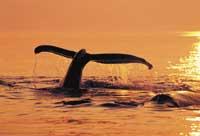Bridge between mammals and Earth whales

50 million years ago, in the present desert of Pakistan, two species of mammals passed from one to the other. They had a canine shape, but were actually four-legged whales. The new discoveries are the bridge between whales and terrestrial mammals, of great importance. Among other things, because they fix a new patch between two branches in the mammalian family tree.
The smallest fossil found has been called Ichthyolestes and the largest Pakicetus. They have carnivorous teeth (although they do not have real fangs) and tail longer and stronger than dogs, longer tip and smaller eyes. Both have special bones in the ears that only the whales have. On the heel there is also a special bone, which have archtiodactyl ungulates like deer or sheep, although deeper studies relate cetaceans and archtiodactyls, but place them in different groups.
Other fossils of 47 million years ago, found in Pakistan, also have the ankle bone of the ungulates, but their branches are more adapted to water.
Due to the appearance of whales (so different from terrestrial mammals, with rowing legs and tip on the top of the head), it has been very difficult to place them in the right place of the evolutionary tree. Depending on the fossils found above they were associated with mesonicians (group of carnivores disappeared). However, new discoveries indicate that they were similar to hippos, and would probably form a group close to them. Molecular data also coincide with the new classification.
Buletina
Bidali zure helbide elektronikoa eta jaso asteroko buletina zure sarrera-ontzian











